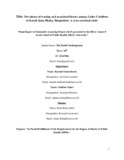Prevalence of wasting and associated factors among under 5 children in Korail slum, Dhaka, Bangladesh: a cross-sectional study

View/Open
Date
2023Publisher
Brac UniversityAuthor
Tarikujjaman, Md. RabbiMetadata
Show full item recordAbstract
Introduction: Among Bangladeshi children under the age of five (U5), malnutrition is a major
health concern. Wasting is one of the malnutrition symptoms associated with malnourished
children's deaths. Southern Asia has a 14.1% prevalence of wasting, according to the world
nutrition survey. According to the Global Nutrition Report, the prevalence of wasting among
under-5 children is 9.8% in Bangladesh.
Objective: The goal of this research to assess the prevalence and associated factors of wasting
among Under 5 children in Korail slum.
Method: A descriptive cross-sectional study was conducted among 342 children under the age
of five living at Korail slum in Dhaka city from October 15, 2022 to January 11, 2023. A
standard anthropometric measurement method was used for the measurements. The
measurements were height and weight. Software named STATA 17 was used to analyze the data.
A multivariate and bivariate logistic regression analysis was conducted.
Findings: In this study, the mean age of under-5 children was 26.7 months. Male was 54.4% and
female was 45.6%. 10.23% of the anthropometric assessment was wasted based on the weight
for height Z-score. According to the study, females were more likely to suffer from wasting than
males.
Conclusion: In Bangladesh, under nutrition among children under the age of five is a public
health problem. We observed that the prevalence of wasting in Korail was slightly higher than
the national prevalence. To reduce the wasting status of children under 5 years old, the
government, nongovernmental organizations, and the community must work together.
